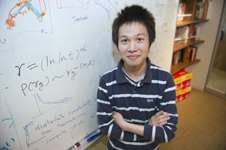Doing the math on where people go

Network scientists at Northeastern University have created a mathematical model that can simulate human mobility over the course of several months or even years.
The results of the study were reported this week in the online edition of Nature �鶹��Ժics magazine.
Distinguished Professor of �鶹��Ժics Albert-László Barabási and his team uncovered the patterns characterizing human mobility by analyzing the real-time movements of three million anonymous cell-phone users and the anonymized positional records of one thousand users whose location was recorded every hour for a two-week period.
A previous study conducted by Barabási’s team found that human mobility is 93 percent predictable in the short-term, a result that could be applied to revamping our system of traffic control.
The team’s newest research findings could be applied to solving much larger problems in fields as diverse as public health, city planning and economic forecasting, says Barabási, who is also director of Northeastern’s world-leading Center for Complex Network Research.
Using the new model, network scientists could accurately predict the spread of biological pathogens in a human population or track the proliferation of mobile-phone viruses.
“Our model captures the universal properties of human mobility,” said Chaoming Song, research associate for the Center for Complex Network Research and lead author of the paper. “That is, if the model generates huge amounts of trajectories, it raises quite similar patterns as the real ones across a population.”
Conventional models for human mobility have relied unsuccessfully on tracking the mobility patterns of animals, said Song. That hasn’t worked because humans generally travel short distances and follow simple reproducible patterns, whereas animals regularly move over hundreds or even thousands of miles.
The team found that people only move across about 12 miles of their neighborhoods each year, Song said, adding that the number of distinct places that humans visit decreases rapidly over time. Migrating animals explore as much as 6,000 miles.
Additional coauthors on the paper, titled “Modeling the Scaling Properties of Human Mobility,” are Tal Koren, a research associate in the Center for Complex Network Research, and Pu Wang, a postdoctoral research associate in civil and environmental engineering at MIT and a former research assistant at the Center for Complex Network Research.
Provided by Northeastern University




















